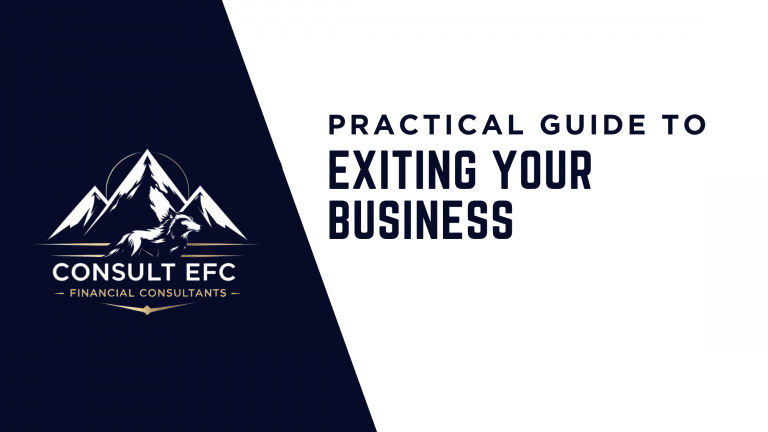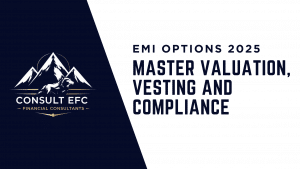Selling or passing on your business is a big life step. It affects your money, your time, and your team. You want a fair price, a clean process, and a steady hand from start to finish.
This guide shows how to plan and deliver a strong exit. It covers the key routes, the steps to lift value, and how to protect the price during due diligence. It is written for UK owners of profitable SMEs planning a sale in 12 to 36 months. The core aim is simple: leave with the right number after tax, protect your people, and pick the path that fits.
You will see the main options, from trade sale and management buyout to employee ownership trust and private equity. You will also see where Consult EFC can help. We provide a clear view on valuation, exit route advice, and a calm, well run process. Expect simple language, firm guidance, and no fluff.
Set your exit goals and pick the right route
Before you talk to any buyer, define success. Clear goals shape deal structure, tax, timing, and who you approach. They also keep you in control when options multiply. Focus on what you care about most: life after exit, money in the bank, and legacy.
Know your number and life after exit
Start with your personal goals. Decide if you want a full exit, or if you will keep a stake for a second bite later. Think about how long you want to stay after completion, and what you will do in that period. Note your handover role, such as client introductions, team mentoring, or product roadmap support.
Then work out your net proceeds. List debt to clear. Estimate tax on the sale and the fees you will pay. Add the cash you need for your plans, such as a new home, investments, or family support. Link this to a post-sale income plan, so you know where earnings will come from once your salary ends.
Set a realistic timing window. Your health, family plans, and market conditions all matter. Sector cycles, interest rates, and buyer activity shift over time.
Simple prompt: write down the minimum net number you will accept and a preferred number. Keep both in view as you shape the deal.
Choose the exit route that fits your goals
Each route suits a different set of goals, price expectations, and team plans. Use plain rules of thumb before you drill into detail.
- Trade sale: best when a strategic buyer values synergies, such as cross-sell or cost savings. This can lift price. Many buyers want you to stay for a period to support handover.
- Management buyout (MBO): works well if you want continuity with a known team. Price is funded by debt and cash flow, and often includes staged payments.
- Employee ownership trust (EOT): protects culture and can deliver 0% CGT on a qualifying sale. It suits steady profits and a strong team. Price is set by an independent valuation and paid out over time.
- Private equity: brings growth support and lets you de-risk now, with a second bite later when the business grows. Governance steps up, and reporting becomes more formal.
A share sale is common. An asset sale can fit when buyers want selected assets and contracts. Keep jargon light, and compare outcomes against your goals.
A quick view can help:
| Route | When it fits best | Typical price profile | Time you stay | Cash timing |
|---|---|---|---|---|
| Trade sale | Strategic buyer, synergies, scale | Often higher due to synergies | Short to medium | More cash at completion, some deferred or earn out |
| MBO | Strong team, owner wants continuity | Fair, linked to cash flow | Medium | Mix of completion cash and staged payments |
| EOT | Culture first, stable profits | Valuation at fair market value | Short to medium | Paid over time, tax efficient for seller |
| Private equity | Growth runway, owner wants rollover | Competitive on platform deals | Medium to long | Split between completion cash and rollover equity |
Map a realistic timeline and milestones
A typical exit timeline runs 12 to 24 months. The steps are simple if you start early and keep pace.
- Months 0 to 3: set goals, choose a route, run a value diagnostic, and start tax planning.
- Months 3 to 9: exit readiness work. Tidy accounts and contracts. Build the data room.
- Months 9 to 12: prepare materials, build a buyer longlist, and make soft soundings.
- Months 12 to 18: outreach under NDA, management meetings, indicative offers, and heads of terms.
- Months 18 to 24: due diligence, legal documents, completion, and handover.
Starting early lifts value and cuts risk. Buyers pay more for clean data, clear plans, and steady performance.
How Consult EFC designs your exit plan
A good plan saves time and stress. It also protects price. Here is how we guide owners.
- Exit readiness review: a fast assessment of value drivers, risks, and easy wins that matter to buyers.
- Route compare: side by side pros and cons for trade sale, MBO, EOT, or private equity based on your goals.
- Value and tax view: what drives your price, and how net cash changes under each structure.
- Timeline and actions: a focused plan with owners, dates, and deliverables. Calm, firm, and clear.
Get exit ready: lift value and reduce risk before you sell
Buyers pay most for reliable profits, strong cash conversion, and low risk. They move faster when records are clean and questions have clear answers. This section sets out the work that moves the needle.
Clean financials and normalised EBITDA
Buyers want three years of clean, comparable accounts with monthly management packs. That means consistent revenue recognition, clear cost categories, and reconciled balance sheets.
Focus on normalised EBITDA. Remove one off income and costs, adjust owner pay to a market rate, and separate non-trade items like a personal car or family costs. Show a sensible add back schedule and keep evidence in the data room.
Working capital matters. Show a normal level and seasonal swings. Reduce old debtors and dead stock. Prove cash collection discipline. Make cash tie to profit with a clear bridge. Fix leaks before you go to market, such as inconsistent billing or weak credit control.
Quality of earnings can speed diligence. A vendor report from a reputable firm can support the price and smooth the Q&A. It gives both sides a shared base of facts.
Strengthen your team and lock in revenue
Cut key person risk. Define roles and document processes. Set clear succession for founder tasks. If one person holds sales, product, and finance, the buyer will worry.
Review contracts. Renew key customer and supplier agreements, and add fair terms on pricing, renewal, and termination. If you sell on purchase orders alone, try to move to simple framework agreements where possible.
Sort staff matters. Tidy employment contracts, update job descriptions, and set incentives that support the period after sale. Retention plans for key managers reduce risk on both sides.
Check customer health. Track concentration risk and churn. Show pipeline by stage with evidence to back it up. Buyers value recurring and contracted revenue. They discount wishful thinking.
Tidy legal matters and protect IP
Legal housekeeping avoids last minute price chips. Put core items in order.
- Share register, options, and any past agreements need to match Companies House and board minutes.
- IP ownership is clear, with assignments from contractors. Register trademarks and patents where relevant.
- Compliance is current, from data protection and health and safety to licences and insurance.
- Any disputes are settled or disclosed early with a brief note on context and status.
Build a clear growth story with evidence
Buyers pay for the future, not just the past. Set a simple growth plan. Explain what drives growth, what it costs, and the expected return. Tie it to hiring, marketing, product, or capacity.
Add evidence. Show pipeline by stage, win rates, and average deal size. For recurring revenue, include cohort data, churn, and expansion metrics. Keep it plain and verifiable.
Pick a small set of KPIs that matter: gross margin, customer lifetime value, churn, and capacity. Show the trend and the driver behind each change.
Add proof points. Share recent wins, case studies, and product or service upgrades. Use short, factual notes. Buyers like truth they can check.
Run and close the deal: process, structure, due diligence, and tax
A strong process protects pace and price. It also reduces the chance of late surprises. Think of it as a relay with smooth handovers and clear roles.
Build your deal team and set roles
Get the right team and set rules of play at the start.
- Corporate finance adviser (Consult EFC): leads strategy, buyer outreach, negotiations, and timetable.
- Legal: an M&A lawyer who drafts and negotiates heads of terms, the SPA, and the disclosure letter.
- Tax: plans for Business Asset Disposal Relief, EOT checks, and pre-sale steps such as share reorganisation.
- Finance: your internal team or a fractional FD to manage data and Q&A.
Agree roles, response times, and decisions. Keep a simple weekly rhythm so the process moves.
Buyer list, outreach, IM, and data room
Prepare smart, then go to market with control.
- Target list: a focused set of strategic buyers, sponsors, and credible MBO funding sources. Match them to your growth and culture.
- Outreach: controlled, under NDA, with clear and consistent messaging. Keep confidentiality tight.
- Information Memorandum: simple story, clean numbers, growth drivers, and risks with mitigations. Buyers respect clarity.
- Data room: organised folders, version control, audit trail, and redactions where needed. Keep it tidy and current.
Tip: answer the hard questions before they are asked. If there is a known issue, prepare the facts and the fix.
Offers, Heads of Terms, and deal structures
Compare offers on more than the headline price. Structure drives net cash, risk, and your time after completion.
- Key terms: price, cash at completion, earn out metrics and length, rollover equity terms, and vendor loan notes.
- Balance sheet: locked box vs completion accounts. Locked box fixes value at a past date and shifts leakage risk to the buyer. Completion accounts adjust price after completion based on actual working capital and cash.
- Protections: exclusivity length, break fees, and access to information.
- Negotiation: keep competitive tension until heads of terms are signed.
A plain example helps. Offer A is £10m, with £8m at completion and £2m earn out over two years, tied to EBITDA. Offer B is £9.5m all cash on a locked box, with no earn out. If you view the earn out as high risk, Offer B may deliver higher net and lower stress. The right choice depends on your confidence in the plan and your appetite for risk.
Due diligence, key documents, and tax planning
Stay calm and methodical. Due diligence is a test of systems and truth, not a trial. Plan the work and keep pace.
- Due diligence: financial, legal, commercial, tax, and technical. Use a Q&A log and a weekly rhythm to track and clear items.
- Documents: the Share Purchase Agreement sets the deal terms. The disclosure letter lists what you have told the buyer so that warranties are fair. Warranties cover the state of the business at completion. Indemnities cover specific risks.
- Tax: plan early for Business Asset Disposal Relief. Check if a share sale or asset sale suits your case. Time any option exercises with care to avoid unwanted tax. Consider if an EOT fits your goals and profit profile.
- Handover: agree time, role, and any earn out milestones. Write a simple handover plan, including client calls, team sessions, and reporting.
Quality prep cuts price chips and delays. It also reduces the strain on you and your team.
How Consult EFC runs a calm, competitive process
Owners want a well run sale with a clean close. That is what we do. Our approach is practical and direct.
- Clear valuation view: we explain the range and the drivers. You see what buyers will pay for and what will worry them.
- Route advice that fits: we compare trade sale, MBO, EOT, and private equity against your goals, timeline, and tolerance for risk.
- Buyer outreach with focus: we build a targeted list, manage NDAs, and tell your story with clarity. We keep pace and protect competitive tension.
- Tight negotiations: we compare offers on full terms, not just price. We show how structure affects net cash and time after completion.
- Steady execution: we run diligence with a weekly plan, keep the data room current, and coordinate your legal and tax team. Calm beats drama.
Common mistakes to avoid
Learn from patterns that reduce price or slow the deal.
- Late tax planning: leave it too late and you lose reliefs. Start 12 to 24 months out.
- Messy numbers: weak management packs slow diligence and invite price chips.
- Overstated add backs: buyers test every adjustment. Keep them real and evidenced.
- Single buyer focus too early: lose tension, lose price. Build choice first.
- No plan for your role: unclear handover terms cause friction and risk.
- Ignoring working capital: surprises at completion accounts can hurt net cash.
Fix these early and you stack the odds in your favour.
A simple pre-sale checklist
- Goals and numbers written down, including minimum and preferred net.
- Three years of clean accounts and monthly packs ready.
- Normalised EBITDA schedule prepared with evidence.
- Working capital profile and cash conversion plan in place.
- Contracts, IP, and compliance up to date.
- Team roles, incentives, and retention plan agreed.
- Growth plan with clear drivers and proof points.
- Data room structure set, with files named and dated.
- Buyer list, IM outline, and Q&A process agreed.
Tick these off and your process will run smoother.
Conclusion
The message is simple. Set goals early, prepare well, and run a disciplined process. A steady plan beats last minute fixes. You protect price, reduce risk, and save time.
Think in three stages: plan, prepare, and execute. If you want a calm, competitive sale, speak with Consult EFC for a confidential exit readiness review and a clear route map. Even if you are 12 to 24 months out, small steps now can add real value.
Choose clarity, control, and confidence in your exit.






